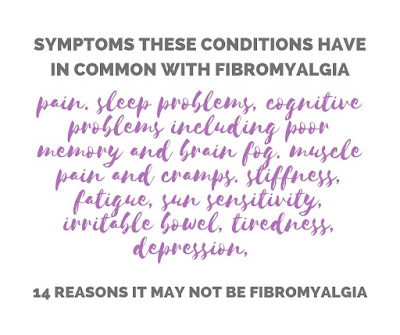The symptoms of fibromyalgia are found in so many other illnesses. That's why diagnosis is problematic. Here are 14 reasons why it may NOT be Fibromyalgia...
Fibromyalgia has many, varied and fluctuating symptoms. It should be considered when a patient describes a history of widespread pain, with no evident cause, that lasts three months or more.
As well as this chronic musculoskeletal pain, whichaffects the bones, ligaments, muscles, nerves and tendons they have fatigue and sleep problems and stiffness. These symptoms are usually accompanied by a number of other conditions such as sensitivity to chemicals, irritable bowel or restless legs and depression or anxiety. The symptoms can often start, or worsen, during a period of severe psychosocial or physical stress.
Fibromyalgia presents a unique medical problem:
- Its symptoms are so common, that it is both underdiagnosed and misdiagnosed.
- Because there are no blood tests or scans to easily diagnose it, many physicians have trouble detecting the disorder.
- It can NOT be easily confirmed or ruled out with a simple blood test.
- It can't be seen on an X-ray or MRI.
- Instead, fibromyalgia appears to be linked to changes in how the brain and spinal cord process pain signals.
Because there is no test for fibromyalgia, your doctor must rely solely on your group of symptoms to make a diagnosis and rule out other conditions.
The key symptoms of fibromyalgia are also commonly found in many other illnesses, and a thorough examination and investigation needs to be undertaken in order to ensure there is not another pathological cause for the symptoms – particularly if there are any ‘red flags’ in the patient’s history suggestive of another serious pathology (Table 1).
|
Doctors need to rule out:
- arthritis
- lupus
- multiple sclerosis
- chronic fatigue syndrome
- polymyalgia rheumatica
- hypothyroidism
- depression
- polymyositis
- hyperparathyroidism
- adrenal insufficiency
- myasthenia gravis
- cushing’s syndrome
- sjogren's syndrome
- Infection: chronic viral infection, HIV, hepatitis, Lyme disease
So if a doctor asks you about your mood, or skin rashes, or sends you for a blood test of your antibodies or an MRI they are just doing their job. They are ruling out these 14 conditions which have similar symptoms to Fibromyalgia. It is important to do so because these 14 conditions have specific treatments.
Symptoms NOT usually found in Fibromyalgia include: - arthritis: swelling and redness, loss of motion in joints
- lupus: butterfly-shaped rash across cheeks and nose, anemia, abnormal blood clotting
- multiple sclerosis: brain lesions on an MRI
- chronic fatigue syndrome: profound fatigue that is more intense than pain, sore thoat
- polymyalgia rheumatica: average age of onset is 70, elevated levels of inflammatory proteins in blood.
- hypothyroidism: thyroid autoantibodies are common
- depression:
- polymyositis: muscle weakness in proximal muscles: upper arms, thighs.
- hyperparathyroidism: presence of hypercalcemia
- adrenal insufficiency: severe exhaustion, not typically associated with chronic widespread pain.
- myasthenia gravis: neurologic signs characteristic of specific disease.
- cushing’s syndrome: characteristic facial and skin signs of Cushing’s syndrome
- sjogren's syndrome: dry eyes and dry mouth, presence of anti bodies specific to Sjogren's
- Infection: chronic viral infection, HIV, hepatitis, Lyme disease
I suggest that you keep a diary of your symptoms. This should make it easier to talk to your doctor or specialist. Especially if you have memory problems, writing things down will provide the doctor with the information that they need to make a correct diagnosis.
When you go to a consultation go with:
- a list of questions
- a list of current medications
- a brief medical history including your parents main conditions
- a list of your symptoms
More clues for fibromyalgia diagnosis (from MayoClinic)Remember that all ongoing pain should be evaluated. I am saying this because after a while of not getting a diagnosis you may start to question whether the pain is all in your head.
People who have fibromyalgia also often wake up tired, even after they've slept continuously for more than eight hours. Brief periods of physical or mental exertion may leave them exhausted. They may also have problems with short-term memory and the ability to concentrate. If you have these problems, your doctor may ask you to rank how severely they affect your day-to-day activities.
Fibromyalgia often coexists with other health problems, so your doctor may also ask if you experience:
- Irritable bowel syndrome
- Headaches
- Jaw pain
- Anxiety or depression
- Frequent or painful urination
Lee Good has 20+ years of experience helping people with chronic illness to understand research information and is recognized as a leader in patient advocacy. She is the WEGO winner, 2018/19 for building the best patient community around Fibromyalgia and editor at Fibro Blogger Directory, which is a community of fibromyalgia bloggers.
RESOURCES:
Fibromyalgia: Understand the diagnosis process MayoClinic
Diagnostic challenges: Australian Family Physician
Musculoskeletal Pain: Cleveland Clinic
Other interesting articles:
- Practical Tips for Weather Sensitivity when living with Fibromyalgia



All of this is great information. Getting a Dr to follow thru, not so great. I hurt so bad even my back fat hurts.
ReplyDelete